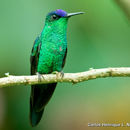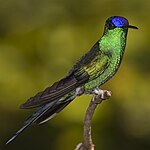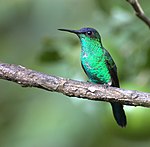pt-BR
nomes no trilho de navegação


Thalurania glaucopis ye una especie d'ave de la familia Trochilidae. Ye un miembru del xéneru Thalurania. Distribuyir nes selves del este d'América del Sur.
Distribuyir nes selves del sudeste de Brasil, nos estaos de: Bahia, Minas Gerais, Espírito Santu, Rio de Janeiro, São Paulo, Mato Grosso del Sur, Paraná, Santa Catarina, y Rio Grande do Sul,[1] l'este del Paraguái, hasta'l nordés de l'Arxentina onde habita na provincia de Misiones.[2] Rexistros dudosos nel nordeste del Uruguái.
El so hábitat natural ye la selva húmeda semitropical y tropical. Tamién habita en selves secundaries o degradaes, parques y xardinos.
Ye una pequeña ave d'unos 9 cm de llongura nel casu del machu, y 8 cm na fema. El picu ye delgáu, rectu, negru, afechu pa l'absorción de néctar y a la captura d'inseutos. La so llongura ye de 20 mm. El machu estremar por ser verde brillante polo xeneral, cola frente y corona celeste azul o violácea, y esibir una bien ahorquillada cola azul escuru. La fema escarez del azul de la cabeza, y tien la totalidá de les partes inferiores de color blancu buxu, y la cola más curtia, col ápiz blancu.[3]
Foi descrita orixinalmente por Johann Friedrich Gmelin nel añu 1818 sol nome de: Trochilus glaucopis con llocalidá típica: «Brasil». Ye una especie monotípica. Forma una superespecie con Thalurania watertonii.[4]
 Esta páxina forma parte del wikiproyeutu Aves, un esfuerciu collaborativu col fin d'ameyorar y organizar tolos conteníos rellacionaos con esti tema. Visita la páxina d'alderique del proyeutu pa collaborar y facer entrugues o suxerencies.
Esta páxina forma parte del wikiproyeutu Aves, un esfuerciu collaborativu col fin d'ameyorar y organizar tolos conteníos rellacionaos con esti tema. Visita la páxina d'alderique del proyeutu pa collaborar y facer entrugues o suxerencies. Thalurania glaucopis ye una especie d'ave de la familia Trochilidae. Ye un miembru del xéneru Thalurania. Distribuyir nes selves del este d'América del Sur.
Aderyn a rhywogaeth o adar yw Nymff goed benfioled (sy'n enw benywaidd; enw lluosog: nymffau coed penfioled) a adnabyddir hefyd gyda'i enw gwyddonol Thalurania glaucopis; yr enw Saesneg arno yw Violet-capped woodnymph. Mae'n perthyn i deulu'r Sïednod (Lladin: Trochilidae) sydd yn urdd y Apodiformes.[1]
Talfyrir yr enw Lladin yn aml yn T. glaucopis, sef enw'r rhywogaeth.[2] Mae'r rhywogaeth hon i'w chanfod yn Ne America.
Mae'r nymff goed benfioled yn perthyn i deulu'r Sïednod (Lladin: Trochilidae). Dyma rai o aelodau eraill y teulu:
Rhestr Wicidata:
rhywogaeth enw tacson delwedd Seren goed torch biws Myrtis fanny Sïedn cleddbig Ensifera ensifera Sïedn clustfioled brown Colibri delphinae Sïedn clustfioled tinwyn Colibri serrirostris Sïedn cynffonnog coch Sappho sparganurus Sïedn cynffonnog efydd Polyonymus caroli Sïedn dreinbig melynwyrdd Chalcostigma olivaceum Sïedn gên emrallt Abeillia abeillei Sïedn y werddon Rhodopis vesperAderyn a rhywogaeth o adar yw Nymff goed benfioled (sy'n enw benywaidd; enw lluosog: nymffau coed penfioled) a adnabyddir hefyd gyda'i enw gwyddonol Thalurania glaucopis; yr enw Saesneg arno yw Violet-capped woodnymph. Mae'n perthyn i deulu'r Sïednod (Lladin: Trochilidae) sydd yn urdd y Apodiformes.
Talfyrir yr enw Lladin yn aml yn T. glaucopis, sef enw'r rhywogaeth. Mae'r rhywogaeth hon i'w chanfod yn Ne America.
Die Blaukronennymphe (Thalurania glaucopis) ist eine Vogelart aus der Familie der Kolibris (Trochilidae), die in Brasilien, Paraguay, Uruguay und Argentinien vorkommt. Der Bestand wird von der IUCN als nicht gefährdet (Least Concern) eingeschätzt. Die Art gilt als monotypisch.[1]
Die Blaukronennymphe erreicht eine Körperlänge von etwa 8 bis 11 cm, bei einem Gewicht der Männchen von ca. 4,0 bis 6,1 g und der Weibchen von ca. 4,0 bis 5,0 g. Das Männchen hat einen mittellangen schwärzlichen Schnabel, wobei die Spitze des Unterschnabels dunkelbraun ist. Der Oberkopf glitzert violettblau. Die Oberseite ist goldgrün. Die Unterseite glänzt grün. Die Unterschwanzdecken sind grünlich bis bläulich, an der Seite gräulich-braun. Der gegabelte Schwanz ist stahlblau. Dem Weibchen fehlt die markante Färbung des Oberkopfs. Die Unterseite inklusive der Unterschwanzdecken ist schmutzig weiß bis hell gelbbraun. Die inneren Steuerfedern des leicht gegabelten Schwanzes sind metallisch grün, die äußeren Steuerfedern stahlblau mit weißen Spitzen. Noch nicht ganz ausgewachsene Männchen haben einen türkisblauen Oberkopf mit vereinzelten violettblauen Federn. Die Kehlfedern werden am unteren Ende von weißlichen Streifen begrenzt. An der Brust, am Bauch und an den Unterschwanzdecken haben sie gräulich-braun gefärbte Bereiche.[2]
Die Blaukronennymphe bezieht ihren Nektar von einer breiten Auswahl einheimischer und eingeführter Pflanzen, die vom Unterholz bis in die Baumkronen reichen. In Waldgebieten gehören Epiphyten wie die zu den Bromeliengewächsen gehörende Gattung Vriesea oder die Art Aechmea maculata, Orchideen, Pfeilwurzgewächse, die zu Marcgraviaceae gehörende Art Schwartzia brasiliensis, Bananengewächse, Passionsblumengewächse, Hülsenfrüchtler der Gattung Dahlstedtia und der Art Erythrina falcata, Ingwergewächse, Rötegewächse, Wollbaumgewächse, Ritterspornbäume, Strelitziengewächse und Helikonien zu ihren Nektarquellen. In Gärten fliegt sie Malvengewächse der Gattung Hibiskus und Abutilon, Wolfsmilchgewächse der Gattung Poinsettia, Dickblattgewächse der Gattung Kalanchoe und Hülsenfrüchtler der Gattung Erythrina an. Außerdem gehören verschiedene Baumarten der Gattung der Zitruspflanzen, Anacardium, Dombeya und Eukalypten zu ihren Nektarquellen. Auch kleine Insekten – inklusive Zweiflüglern und Schmetterlingen – gehören zu ihrer Nahrung. Diese sammelt sie von den Pflanzen oder jagt ihnen nach. Bei einem kontrollierten Versuch an künstlichen Futterstationen wurde festgestellt, dass die Blaukronennymphe Nektar mit mineralhaltigen Zusätzen denen mit vitaminhaltigen Zusätzen vorzieht.[2]
Der Gesang besteht aus einer monotonen Reihe gleichmäßiger metallischer Tschilplaute, die wie tschip..tschip..tschip.. klingen und in einer Frequenz von ca. 5 bis 10 Tönen pro Sekunde abgegeben werden. Gelegentlich beschleunigt sich die Frequenz der Laute bis zu einem Rasseln. Der Ruf beinhaltet kurze trockene Tschilps, die die Vögel oft in schneller Folge von sich geben oder aus einem trockenen Getriller und Geschnatter im Flug.[2]
Die Brutsaison dauert von September bis Februar. Das kugelförmige Nest wird aus weicher Pflanzenwolle und Fasern z. B. von Süßgräsern, Rohrkolben, Wollbaumgewächsen und Bromeliengewächsen gebaut. Zur Verkleidung der Außenseite verwenden die Blaukronennymphen Farnschuppen und Flechten. Diese bedecken teils die ganze Außenschicht des Nests. Das Nest platzieren sie an einem horizontalen Ast oder Verzweigungen in Bäumen beispielsweise der Gattung Chusquea in Höhen von 1,5 bis 3,0 Metern über dem Boden. Die zwei etwa 0,5 g schweren weißen Eier sind ca. 12,2 bis 15,0 × 7,8 bis 10,0 mm groß. Die Brutdauer beträgt 15 Tage und die Bebrütung der Eier erfolgt durch das Weibchen. Nach 20 bis 25 Tagen werden die Nestlinge flügge.[2]
Die Blaukronennymphe bevorzugt unberührte Wälder, Waldränder und Gestrüpp. Trotzdem sieht man sie auch in vorstädtischen Gegenden mit Parks und Gärten, gelegentlich sogar in Stadtzentren. Sie lebt in Höhenlagen vom Meeresspiegel bis auf 850 Meter.[2]
Die Blaukronennymphe gilt als Kurzstreckenwanderer. Auch wenn Uruguay als Verbreitungsgebiet genannt wird, gibt es keine bestätigten Brutaktivitäten in diesem Land. Das Verbreitungsgebiet Richtung Süden ist nicht genau bekannt. Eventuell handelt es sich bei den wenigen Beobachtungen um Irrgäste.[2]
Die Erstbeschreibung der Blaukronennymphe erfolgte 1788 durch Johann Friedrich Gmelin unter dem wissenschaftlichen Namen Trochilus glaucopis. Das Typusexemplar stammt aus Brasilien.[3] John Gould hatte 1848 die Gattung Thalurania für eine Unterart der Schwalbennymphe (Thalurania furcata viridipectus) eingeführt.[4][A 1] »Thalurania« leitet sich aus den griechischen Worten »thalos, τηαλοσ« für »Kind, Nachkomme« und »ouranos, οὐρανός« für »Himmel« ab.[5] Das Artepitheton »glaucopis« ist ein griechisches Wortgebilde aus »glaukos γλαυκός« für »blaugrau, glauk, hellgrün« und »opsis οψις« für »Aussehen, Erscheinung«.[6]
Die Blaukronennymphe (Thalurania glaucopis) ist eine Vogelart aus der Familie der Kolibris (Trochilidae), die in Brasilien, Paraguay, Uruguay und Argentinien vorkommt. Der Bestand wird von der IUCN als nicht gefährdet (Least Concern) eingeschätzt. Die Art gilt als monotypisch.
The violet-capped woodnymph (Thalurania glaucopis) is a species of hummingbird in the "emeralds", tribe Trochilini of subfamily Trochilinae. It is found in Argentina, Brazil, Paraguay, and Uruguay.[3][4]
The violet-capped woodnymph was formally described in 1788 by the German naturalist Johann Friedrich Gmelin in his revised and expanded edition of Carl Linnaeus's Systema Naturae. He placed it with all the other hummingbirds in the genus Trochilus and coined the binomial name Trochilus glaucopis.[5] Gmelin based his description on "L'oiseau-mouche à queue fourchue du Brésil" that had been described and illustrated in 1760 by the French zoologist Mathurin Jacques Brisson from a preserved specimen that had been sent to Paris from Brazil.[6] The violet-capped woodnymph is now placed with three other woodnymphs in the genus Thalurania that was introduced in 1848 by the English ornithologist John Gould.[7][3] The genus name combines the Ancient Greek thalos meaning "child" with ouranos meaning "heaven". The specific epithet glaucopis is from the Ancient Greek glaukos meaning "blue-grey" or "glaucous" with ōps meaning "face".[8] The species is treated as monotypic: no subspecies are recognized.[3]
The violet-capped hummingbird is 8 to 11 cm (3.1 to 4.3 in) long. Males weigh 4 to 6.1 g (0.14 to 0.22 oz) and females 4 to 5 g (0.14 to 0.18 oz). Both sexes have a medium length straight bill that is blackish and sometimes has a dark brown tip to the mandible. The adult male has a glittering violet-blue forehead and crown, dark golden-green upperparts, and a steel blue forked tail. Its underparts are brilliant green with greenish to bluish undertail coverts. The adult female is entirely green above and dirty white to pale buff below. Its tail is only slightly forked; its inner feathers are metallic green and the outer ones steel blue with white tips. Subadult males have a turquoise-blue forehead and crown, whitish bars on the thoat feathers, and grayish brown areas on its underparts.[9]
The violet-capped woodnymph is found in eastern and southeastern Brazil from Bahia to Rio Grande do Sul, northeastern Argentina's Misiones Province, eastern Paraguay, and northern Uruguay. It inhabits the interior and edges of primary forest, scrublands, and suburban and urban parks and gardens. In elevation it ranges from sea level to 850 m (2,800 ft).[9][10]
The violet-capped woodnymph is a short-distance migrant but details are not known. It is found in Paraguay only in the non-breeding season.[9]
The violet-capped woodnymph forages for nectar at all levels of its habitat and from a very wide variety of flowering plants, shrubs, and trees. In addition to nectar it captures small insects by hawking from a perch and by gleaning from vegetation.[9]
The violet-capped woodnymph's breeding season spans from September to February. It makes a bowl nest of soft plant down and fibers with fern scales and lichen on the outside. It is typically placed on a horizontal branch or fork between 1.5 and 3 m (5 and 10 ft) above the ground. The female incubates the clutch of two eggs for about 15 days and hatching occurs 20 to 25 days after hatch.[9]
What is thought to be the violet-capped woodnymph's song is "a monotonous rapid series of evenly spaced metallic chips, 'chip..chip..chip...'". In flight it makes "short dry chips, often [as a] dry trill or chatter".[9]
The IUCN has assessed the violet-capped woodnymph as being of Least Concern. It has a large range but its population size and trend are not known. No immediate threats have been identified.[1] It is "[o]ne of commonest trochilids in SE Brazil" and occurs in many protected areas there.[9]
The violet-capped woodnymph (Thalurania glaucopis) is a species of hummingbird in the "emeralds", tribe Trochilini of subfamily Trochilinae. It is found in Argentina, Brazil, Paraguay, and Uruguay.
El picaflor corona violácea, picaflor corona azul, o colibrí zafiro capirotado (Thalurania glaucopis) es una especie de ave de la familia Trochilidae. Es un miembro del género Thalurania. Se distribuye en las selvas del este de América del Sur.
Se distribuye en las selvas del sudeste de Brasil, en los estados de: Bahía, Minas Gerais, Espírito Santo, Río de Janeiro, São Paulo, Mato Grosso del Sur, Paraná, Santa Catarina, y Río Grande del Sur,[1] el este del Paraguay, hasta el noreste de la Argentina en donde habita en la provincia de Misiones.[2] Registros dudosos en el noreste del Uruguay.
Su hábitat natural es la selva húmeda semitropical y tropical. También habita en selvas secundarias o degradadas, parques y jardines.
Es una pequeña ave de unos 9 cm de largo en el caso del macho, y 8 cm en la hembra. El pico es delgado, recto, negro, adaptado para la absorción de néctar y a la captura de insectos. Su largo es de 20 mm. El macho se distingue por ser verde brillante en general, con la frente y corona celeste azul o violácea, y exhibir una muy ahorquillada cola azul oscuro. La hembra carece del azul de la cabeza, y tiene la totalidad de las partes inferiores de color blanco grisáceo, y la cola más corta, con el ápice blanco.[3]
Fue descrita originalmente por Johann Friedrich Gmelin en el año 1818 bajo el nombre de: Trochilus glaucopis con localidad típica: «Brasil». Es una especie monotípica. Forma una superespecie con Thalurania watertonii.[4]
|fechaacceso= requiere |url= (ayuda) |fechaacceso= requiere |url= (ayuda) |fechaacceso= requiere |url= (ayuda) El picaflor corona violácea, picaflor corona azul, o colibrí zafiro capirotado (Thalurania glaucopis) es una especie de ave de la familia Trochilidae. Es un miembro del género Thalurania. Se distribuye en las selvas del este de América del Sur.
Thalurania glaucopis Thalurania generoko animalia da. Hegaztien barruko Trochilidae familian sailkatua dago.
Thalurania glaucopis Thalurania generoko animalia da. Hegaztien barruko Trochilidae familian sailkatua dago.
Thalurania glaucopis
La Dryade glaucope est une espèce d'oiseaux de la famille des Trochilidae, la famille des colibris.
L'espèce est présente en Argentine, au Brésil, au Paraguay et en Uruguay.
Elle habite les forêts tropicales et subtropicales de plaine et de montagne mais aussi les anciennes forêts fortement dégradées.
Thalurania glaucopis
La Dryade glaucope est une espèce d'oiseaux de la famille des Trochilidae, la famille des colibris.
La driade capoviola (Thalurania glaucopis (Gmelin, 1788)) è un uccello della famiglia Trochilidae, diffuso in Sudamerica.[2]
La specie è presente in Argentina, Brasile, Paraguay e Uruguay.[1]
Abita in foreste tropicali e subtropicali di pianura e di montagna. Si trova anche su siti di antiche foreste fortemente degradate.
La driade capoviola (Thalurania glaucopis (Gmelin, 1788)) è un uccello della famiglia Trochilidae, diffuso in Sudamerica.
De violetkapbosnimf (Thalurania glaucopis) is een vogel uit de familie Trochilidae (kolibries).
Deze soort komt voor van zuidoostelijk Brazilië tot oostelijk Paraguay, noordoostelijk Argentinië en noordelijk Uruguay.
De violetkapbosnimf (Thalurania glaucopis) is een vogel uit de familie Trochilidae (kolibries).
Widłogonek fioletowoczelny (Thalurania glaucopis) – gatunek ptaka z rodziny kolibrowatych (Trochilidae) średniej wielkości. Zwykle spotykany w dolnych piętrach lasów.
Widłogonek fioletowoczelny (Thalurania glaucopis) – gatunek ptaka z rodziny kolibrowatych (Trochilidae) średniej wielkości. Zwykle spotykany w dolnych piętrach lasów.
Wygląd Długość ciała 12 cm. Lekko zakrzywiony, czarny dziób. Samiec – czapeczka fioletowa, grzbiet zielony. Spód ciała złotozielony, ogon rozwidlony, stalowoniebieski. Samica – spód ciała szarawobiały. Widoczne zielone plamy na bokach i ciemnoniebieskim ogonie. Zasięg, środowisko Południowo-wschodnia Brazylia. Pospolity w lasach nizinnych.O beija-flor-de-fronte-violeta[2][3], também conhecido por beija-flor-de-testa-roxa[4], beija-flor-glauco, beija-flor-verde, beija-flor-tesoura-de-cabeça-violeta[5], picaflor-corona-azul[1] ou tesoura-de-fronte-violeta (Thalurania glaucopis; nomeado, em inglês, violet-capped woodnymph)[5][6], é uma espécie de ave da família Trochilidae. Foi classificado por Johann Friedrich Gmelin em 1788[4], com a denominação de Trochilus glaucopis, e descrito na obra Systema Naturae (1, pt.; pág. 497).[1] Seu nome científico significa "pássaro cinza azulado, filho do azul celeste".[3]
Este beija-flor apresenta dimorfismo sexual. O macho é um pouco maior[1], entre 10 a 11 centímetros, possuindo as penas iridescentes de sua fronte azul-arroxeadas e restante do corpo de coloração predominante esverdeada e com retrizes azuis-escuras e alongadas.[4] A plumagem embaixo da cauda, que forma o crisso, é branca e seu bico é negro.[1]
A fêmea é menor (9 centímetros)[4] e não apresenta a fronte azul-arroxeada, sendo verde-iridescente dorsalmente e com as partes inferiores brancas sujas, retrizes laterais com pontas brancas, fronte e lado inferior às vezes lavados de uma cor similar à da canela.[1][2][4]
Fotografia do macho de Thalurania glaucopis na província de Misiones, Argentina.
Fêmeas constroem seus ninhos, que lembram a parte superior de cálices e são feitos de materiais macios, como paina de Malvaceae, Bromeliaceae, Poaceae etc., ou de Typha, e revestidos principalmente com líquens, teias de aranha ou material vegetal de Cyatheaceae; colocados em forquilhas de árvores e arbustos. Antes, durante as cerimônias pré-cópula, o macho executa ao redor da fêmea, pousada, voos semicirculares enquanto exibe o vértice e peito.[1][2][3]
Thalurania glaucopis é encontrado em habitat de florestas tropicais pluviais de sub-bosques, bordas de Mata Atlântica e capoeiras, incluindo jardins em ambientes antrópicos, menos numeroso em regiões com maior estiagem e menos vegetação, mais distantes do litoral, até altitudes de 850 metros. A sua distribuição geográfica vai do sul da região nordeste do Brasil, na Bahia e em Sergipe, passando pelos estados brasileiros da região Sudeste (incluindo Minas Gerais, indo para o Mato Grosso do Sul, na região Centro-Oeste, onde é incomum) e região Sul, até o Paraguai, Uruguai e norte da Argentina. Sua alimentação é constituída, além do néctar das flores, por pequenos artrópodes, caçando insetos e pequenas aranhas, capturados em seu voo. É uma ave territorialista e defende seu espaço e o seu alimento de outras espécies, como o besourinho-de-bico-vermelho.[1][2][3][4][6][7][8]
De acordo com a União Internacional para a Conservação da Natureza (IUCN), esta é uma espécie pouco preocupante, avaliada como de menor importância em seu perigo de extinção (ou em seu estado de conservação), pois tem uma ampla distribuição geográfica que a torna menos suscetível ao impacto humano (extensão da ocorrência com 20.000 quilômetros quadrados).[6]
|coautor= (ajuda) |coautor= (ajuda) O beija-flor-de-fronte-violeta, também conhecido por beija-flor-de-testa-roxa, beija-flor-glauco, beija-flor-verde, beija-flor-tesoura-de-cabeça-violeta, picaflor-corona-azul ou tesoura-de-fronte-violeta (Thalurania glaucopis; nomeado, em inglês, violet-capped woodnymph), é uma espécie de ave da família Trochilidae. Foi classificado por Johann Friedrich Gmelin em 1788, com a denominação de Trochilus glaucopis, e descrito na obra Systema Naturae (1, pt.; pág. 497). Seu nome científico significa "pássaro cinza azulado, filho do azul celeste".
Violettkronad skogsnymf[4] (Thalurania glaucopis) är en fågel i familjen kolibrier.[3] Den förekommer från sydöstra Brasilien till östra Paraguay och nordöstra Argentina.[2] IUCN kategoriserar arten som livskraftig.[1]
Violettkronad skogsnymf (Thalurania glaucopis) är en fågel i familjen kolibrier. Den förekommer från sydöstra Brasilien till östra Paraguay och nordöstra Argentina. IUCN kategoriserar arten som livskraftig.





Thalurania glaucopis là một loài chim trong họ Trochilidae.[1]
Thalurania glaucopis là một loài chim trong họ Trochilidae.